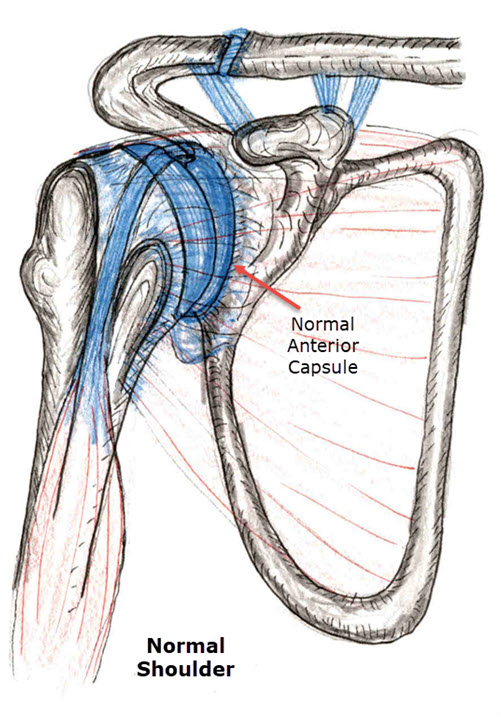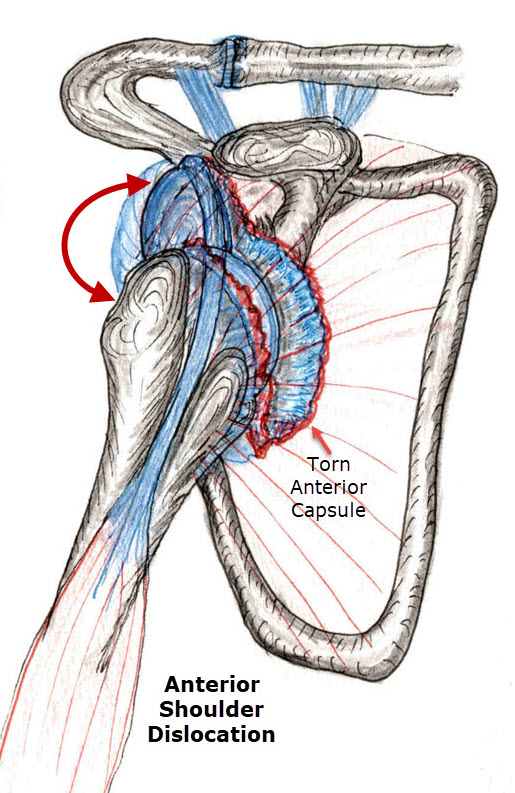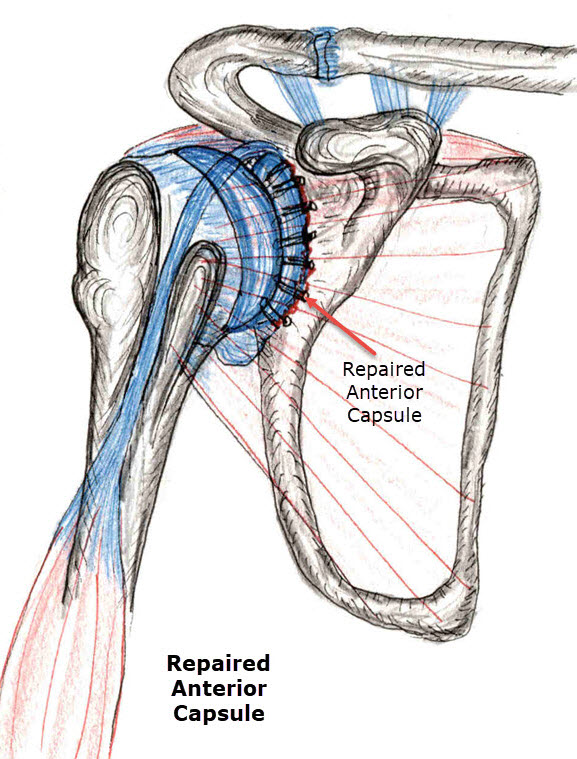Shoulder Dislocation and Reconstruction
Post Operative Instruction After Shoulder Arthroscopy
The shoulder is the most mobile joint in the human body. Greater mobility, however, increases the risk of shoulder dislocation. Simply, the more contact between cup and ball, the more stable the joint. The hip is a simple example of this. Three major forces hold the shoulder joint in place. First, there is a suction between the ball and cup. Second, the capsule and incorporated ligaments of the capsule provide the primary restraint against dislocation. The capsule is often torn or detached from the cup (glenoid) of the joint with an acute traumatic dislocation. Third, the muscles of the rotator cuff act like the reins of a horse holding the humeral head or ball of the joint in place (located). The rotator cuff acts as a dynamic secondary stabilizer. The labrum (lip), a cartilage border between the capsule and cup, also increases the conformity of the joint and the effective diameter of a small glenoid (cup) relative to the large humeral head (ball) of the joint. 
Dislocations can be acute and traumatic as in a sports or work injury, or they can be chronic and relatively atraumatic. The former is generally associated with capsular tears or labral detachment, and effectively destroys the primary stabilizer of the joint. Non-operative management of this injury is generally indicated, however, the recurrence rate is roughly 90% in the twenty-year-old or under. This dramatically decreases with age, and over forty years of age is under 20%. Atraumatic dislocation is often associated with capsular laxity, generalized ligament laxity, and repetitive ligament overload. For this reason, it is commonly seen in the swimmer and throwing athlete. It is often associated with subluxation without frank dislocation. This may make for a confusing constellation of symptoms and a long history without a correct diagnosis. These patients in 85% of cases or more respond to exercise programs which increase the strength of the rotator cuff and the secondary stabilizers of the shoulder.
Symptoms
Symptoms of dislocation are obvious especially when reduction is required by manipulation by a physician. Subluxation, however, may be more elusive. Symptoms here may mimic those of impingement especially in the swimmer or throwing athlete. Overhead work may cause pain with reaching up with the arm externally rotated and may result in apprehension or the sense that dislocation will occur.
Diagnosis
The capsule is often torn or detached from the cup (glenoid) with an acute traumatic dislocation. Diagnosis is generally made by physical exam. Plain X-Ray exam only rules out other problems or injuries associated with dislocation and confirms that the joint is indeed located. MRI is in general not highly sensitive nor specific in the diagnosis of the capsular injury. This can be greatly improved with views done in several positions of rotation. CAT scan enhanced with arthrogram contrast is at least as diagnostic as MRI but is more invasive. Ultimately accurate diagnosis may be made during evaluation of the joint during anesthesia and direct joint evaluation with Arthroscopy. When therapeutic exercise fails to decrease symptoms to a tolerable level, exam under anesthesia with Arthroscopic or open repair for shoulder instability may be indicated. Generally, this follows an intensive rotational strengthening program, unless recurrent dislocation occurs without provocation.
 Orthopedic Surgery
Orthopedic Surgery
Arthroscopic capsular repair of the shoulder to the neck of the glenoid (Bankart repair) is now the most successful and anatomically preserving method of surgical shoulder treatment. Reports give this greater than 95% success rate when performed by an open surgical approach. With this procedure, generalized capsular laxity may be addressed in patients with atraumatic dislocation and subluxation. Open surgery is uncomfortable, and immobilization is required for a full 4 to 6 weeks. Arthroscopic capsular reconstruction is now most common, however, even in the hands of those who developed the techniques, the incidence of redislocation is slightly higher than in open repair. The obvious advantage is less pain after surgery and a short hospital stay (often outpatient). Immobilization should be identical to that with open repair. Less pain with Arthroscopic repair may lead to a higher risk of redislocation because patients tend to begin activities prior to adequate capsular healing with improved comfort when treated arthroscopically. Without surgical reconstruction, recurrent dislocation may lead to shoulder osteoarthritis since dislocation and reduction are both traumatic to the joint.
Complications
As in all surgery, there are risks. The greatest risk is that of repeat dislocation. The risk of infection is below 0.5%. The risk of nerve injury or unresolved pain is also very small. Only you can weigh the risks and benefits of surgery and make an informed decision. 
Rehabilitation
After Arthroscopy describes basic surgical aftercare. As noted above, rehabilitation begins with immobilization and then progresses from isometric (strengthening without motion), to active rotational strengthening, and passive to active motion through a progressively more normal range. Generally, a full range of motion is expected to return by 3-4 months after surgery. No extreme measures should be taken to regain full motion rapidly, or the repair may be damaged. Clearly following specific guidelines for rehabilitation are as important as the repair itself.
Time course
- Sling immobilization 4-6 weeks.
- Isometric strengthening of rotator cuff begins at 4-6 weeks.
- Active strengthening of the rotator cuff and early deltoid strengthening 6-8 weeks.
- Active and passive elevation (elbow and hand above shoulder) 8-10 weeks.
- Light lifting and functional use of the shoulder 4 months post-op.
- Return to relatively normal shoulder use (sports and heavy lifting) 6 months post-op.
Compliments of Sports Medicine and Orthopaedics, East Providence, Rhode Island
